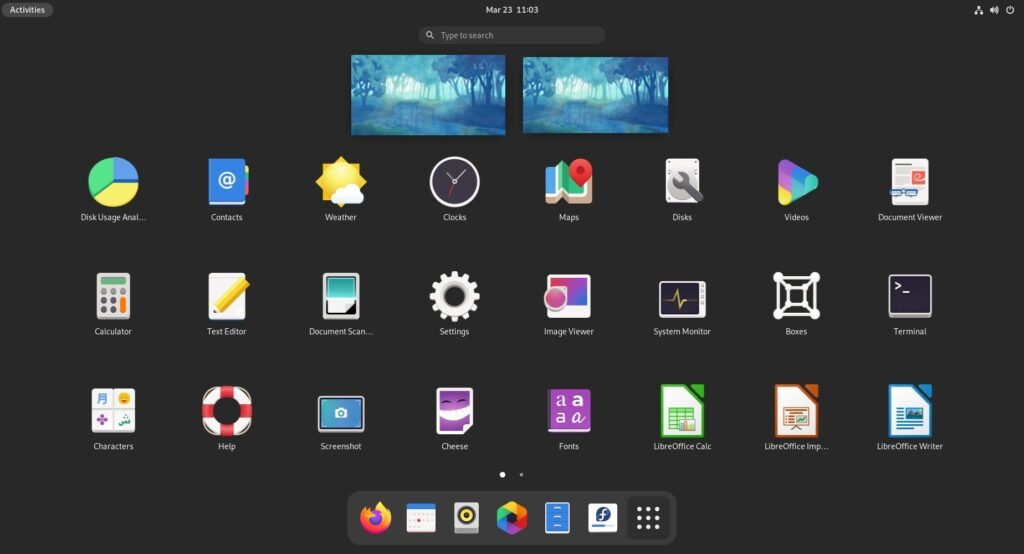The Fedora team announced the release of Fedora 34 Beta with many new improvements and the latest packages. Here’s a summary of the new changes and how to download, test the Fedora 34 Beta.
Fedora 34 brings a massive set of changes across desktop, server, and other spins. Some major desktop environment versions are featured in Fedora 34 as well. In addition to those changes, a new tiling window manager (i3) spin is introduced for the first time which is expected to work out-of-the-box. Although we have feature highlights of Fedora 34 before, let’s take another brief look at the features of Fedora Linux 34.

Table of Contents
Fedora 34 Beta – What’s New
1. Core Updates
Fedora 34 is powered by Linux Kernel 5.11. Linux Kernel 5.11 brings performance improvements, new hardware support across processors, graphics, storage, and network. Check out the feature overview of Linux Kernel 5.11 here.
2. Zstd compression
In the last Fedora 33 release, btrfs is already made as a default file system when installing a fresh system. In this release, the zstd compression is made as default when using btrfs. This enables faster read, write performance while saving disk space significantly.
3. Pipewire as default sound daemon
Today all the audio in your Linux desktop is handled by PulseAudio. Fedora 34 now routes all audio from PulseAudio and JACK to the Pipewire daemon. That means they need the PulseAudio package and the daemon is gone now. PipeWire daemon provides more flexible, high-performance audio management in Linux, better than PulseAudio.
4. Systemd-oomd as default
Fedora 34 enables the systemd-oomd daemon by default for all variants. Earlier it was enabled only for a few. This daemon provides better resource handling of processes during Out-Of-Memory (OOM) situations. The idea of OOM is to recover from out-of-memory situations sooner than a hanging system. The daemon keeps assigning scores to processes based on certain criteria. For example, if your system RAM goes below 4% free and swaps below 10% free, the SIGTERM is issued to those processes with the largest oom_score.
5. Package and toolchain updates
The entire Fedora 34 toolchain and other packages upgraded to their latest releases. Here’s a quick rundown of the updates.
- Binutils 2.35
- Gcc 11
- binutils 2.35
- glibc 2.33.
- Golang 1.16
- IBus 1.5.24
- LLVM 12
- OpenSSL3.0
- Ruby 3.0
- BIND 9.16
- MariaDB 10.5
- Ruby on Rails 6.1
6. New i3 tiling window manager spin
For the first time, Fedora 34 provides a new Tiling Window Manager – i3 flavor. This is a major step in the right direction where you get a ready-to-use Tiling Window manager flavor available with mainstream Linux distribution. Today, if you want to enjoy the tiling window manager, you have to install it manually via dnf and then configure many options such as display server, etc. With this, you get ready to use Fedora spin. This definitely increases the Tiling Window manager user base with Fedora.
7. GNOME 40
The default workstation edition features the latest GNOME 40 which is due release this week. GNOME 40 brings a complete design overhaul at the very core level. And fortunately, the release is in line with Fedora 34 schedule. Here’s a quick feature recap of GNOME 40.
- Multiline Icon Labels in GNOME Shell Grid
- App Grid Scrolls Horizontally
- Search Feature in Native Extensions App
- Workspace Navigation is now horizontal and more productive
- Sorting of Wifi Connections
- GNOME Calendar – reminder time changes
8. KDE Plasma 5.21
The Fedora 34 KDE Spin brings the latest KDE Plasma 5.21. KDE Plasma 5.21 brings a new kickoff menu, Wayland updates, the latest KDE Applications, and many new updates. Check out the feature overview here.
9. Xfce 4.16
The latest Xfce 4.16 desktop is available with Fedora 34. Xfce 4.16 brings many new features such as GTK2 is completely dropped in favor of GTK3, Settings dialog uses CSD, new icon set, fractional scaling, etc after years of development. And you can take advantage of this lightweight Linux distribution with its features. Check out the Xfce 4.16 feature roundup here.
10. LXQt 0.16
LXQt recently releases its latest version LXQt 0.16. And it is stable now. So, the Fedora team decided to upgrade the LXQt base to the latest LXQt 0.16. LXQt 0.16 brings new features which we covered here. Take a look.
Complete change log is available here.
Download and Test
The Fedora 34 .iso image for desktop, servers, and other spins is available below links. Due to the initial rush, the download speed might be slow, so wait for a day to get your copy if you feel the slowness.
Spins and other desktop flavors are available in this link.
You can install them in a virtual machines, or do a fresh install as well.
Closing Notes
Make sure to download and test Fedora 34 Beta. And report any issues in Bugzilla. If you are new to reporting bugs, go through how to file bug documentation. That said, Fedora 34 is impressive and as always following the trends of adopting new packages and features before any other Linux distributions.
Fedora 34 final release expected on April 20, 2021.